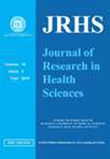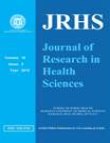فهرست مطالب

Journal of Research in Health Sciences
Volume:18 Issue: 2, Spring 2018
- تاریخ انتشار: 1397/03/07
- تعداد عناوین: 8
-
-
Page 1BackgroundChildhood obesity has become a global epidemic and physical inactivity and considered as one of the most important contributing factors. We aimed to evaluate a school-based physical activity intervention using social cognitive theory (SCT) to increase physical activity behavior in order to prevent obesity among overweight and obese adolescent girls.
Study design: Randomized controlled trial study.MethodsA seven-month randomized controlled trial based on SCT was implemented with 172 overweight and obese girl students (87 in intervention and 85 in control group), with the presence of their parents and teachers. Activities of the trial included: Sports workshops, physical-activity consulting private sessions, free practical and competitive sports sessions, family exercise sessions, text messages, and newsletters. Body Mass Index (BMI) and Waist Circumference (WC) were measured and questionnaires about duration of physical activity, duration of screen time (watching television and playing computer games) and psychological variables regarding the SCT constructs were obtained.ResultsDuration of physical activity (in minutes) and most of psychological variables (self-efficacy, social support, and intention) significantly increased at post-intervention, while hours of watching television and playing computer were significantly decreased (PConclusionsSchool-based intervention using SCT led to an increase in the duration of physical activity and reduction in the duration of screen time in overweight and obese adolescent girls.Keywords: Adolescent, Obesity, Physical activity, Schools -
Page 2BackgroundDespite physical activity having several benefits, a considerable number of Americans do not engage in sufficient exercise. Among the high-risk groups are African American women. A recent theory, multi theory model (MTM) for health behavior change can be used to develop effective interventions. The objective of this research was to test MTM in its ability to predict physical activity behavior in African American women.
Study Design: A cross-sectional study.MethodsAfrican American women aged 18 yr and older were recruited at various locations (primarily churches) of Jackson, a large city in southern Mississippi to participate in this cross-sectional study in 2016. The valid and reliable survey was administered to a G*Power calculated quota sample of 156 women either in person or via a Qualtrics link sent through an e-mail.ResultsThe regression analysis revealed that 32.7% of the variance in initiating physical activity behavior was predicted by participatory dialogue, behavioral confidence, and changes in physical environment. Sustenance of physical activity behavior was predicted up to 38.8% by emotional transformation and changes in social environment.ConclusionsMTM appears to be a robust theory in its application for changing physical activity behavior in African American women. This theory must be reified and empirically tested with this population.Keywords: Exercise, Physical activity, Prevention, control, Methods, Statistical, numerical data -
Page 3BackgroundFood insecurity (FI) refers to the lack of sufficient and safe availability of the food. Accumulating studies have suggested associations between dietary intake and Intelligence quotient (IQ). Accordingly, we aimed to examine the association between FI and IQ.
Study design: Case-control study.MethodsIn this case-control study, 222 girl students aged 9 to 11 years old were randomly chosen from Bandar-Anzali, Iran in 2013. Students with low and moderate IQ were considered as case (n=111) and control (n=111) group, respectively. General and demographic characteristics were collected using interview. United States Department of Agriculture (USDA) household FI questionnaires were also completed. To determine IQ, Wechslers revised intelligence test was used.ResultsFI was observed in 51% of study participants. The prevalence of FI in case and control group was 58.6% and 22.5%, respectively. The mean IQ was 77.97 ±5.56 in case and 94.6 ±5.47 for control group. It was found that there was an inverse association between FI and low IQ. The results of the multiple variable logistic regression analysis (odds ratio and its 95% confidence interval) showed that, FI 3.46 (1.85, 6.50; P>0.001), natural type of delivery 2.45 (1.30, 4.62; P=0.006), and fathers low education level 2.97 (1.43, 6.19; P=0.004) were the risky factors leading to low IQ.ConclusionsThere was an inverse link between FI and IQ. Therefore, it is necessary to pay more attention to FI and its consequences, particularly in mental health of children.Keywords: Food Insecurity, Intelligence Quotient, Primary School, Girl, Iran -
Page 4BackgroundWe aimed to identify the associated risk factors of type 2 diabetes mellitus (T2DM) using data mining approach, decision tree and random forest techniques using the Mashhad Stroke and Heart Atherosclerotic Disorders (MASHAD) Study program.
Study design: A cross-sectional study.MethodsThe MASHAD study started in 2010 and will continue until 2020. Two data mining tools, namely decision trees, and random forests, are used for predicting T2DM when some other characteristics are observed on 9528 subjects recruited from MASHAD database. This paper makes a comparison between these two models in terms of accuracy, sensitivity, specificity and the area under ROC curve.ResultsThe prevalence rate of T2DM was 14% among these subjects. The decision tree model has 64.9% accuracy, 64.5% sensitivity, 66.8% specificity, and area under the ROC curve measuring 68.6%, while the random forest model has 71.1% accuracy, 71.3% sensitivity, 69.9% specificity, and area under the ROC curve measuring 77.3% respectively.ConclusionsThe random forest model, when used with demographic, clinical, and anthropometric and biochemical measurements, can provide a simple tool to identify associated risk factors for type 2 diabetes. Such identification can substantially use for managing the health policy to reduce the number of subjects with T2DM .Keywords: Diabetes mellitus, Decision tree, Random forest, data mining, Iran -
Page 5BackgroundThis study aimed to estimate the prevalence of substance use among university students measured by direct and indirect methods, and to calculate the visibility factor (VF) defined as ratio of indirect to direct estimates of substance use prevalence.
Study Design: A cross-sectional study.MethodsUsing a multistage non-random sampling approach, we recruited 2157 students from three universities in Kerman, Iran, in 2016. We collected data on substance use by individual face-to-face interview using direct (i.e. self-report of their own behaviors) and indirect (NSU: Network scale up) methods. All estimates from direct and indirect methods were weighted based on inverse probability weight of sampling university.ResultsThe response rate was 83.6%. The last year prevalence of water pipe, alcohol, and cigarettes indirect method was 44.6%, 18.1%, and 13.2% respectively. Corresponding figures in NSU analysis were 36.4%, 18.2%, and 16.5% respectively. In the female population, VF for all types of substance was less than male.ConclusionsConsiderable numbers of university students used substances like a water pipe, alcohol, and cigarettes. NSU seems a promising method, especially among male students. Among female students, direct method provided more reliable results mainly due to transmission and prestige biases.Keywords: Prevalence, Visibility, Substance use, University students, Network scale up -
Page 6BackgroundBullying is a serious public health concern remarkably common among youth. Involvement in bullying can lead to deleterious effect on the emotional well-being of pupils. The aim of this study was to assess the prevalence of bullying, its psychosocial associated factors and the perceived involvement of parents, teachers, and classmates to counteract this behavior.
Study Design: A cross-sectional study.MethodsWe conducted this study in 2015 among a representative multistage sample of 1584 students enrolled in middle schools in the Region of Sousse using the revised Olweus Bully/Victim Questionnaire. It assesses the prevalence of bullying and covers qualitative details of bullying including psychosocial factors and perceived efforts of others to counteract bullying.Results11.7% of respondents were classified as pure victims, 7.8% as pure bullies, 3.2% as bully-victims and 75.5% as bystanders. Compared to other groups, the bully-victims were less likely to report a feeling of empathy and liking school. They were more likely to be afraid of being bullied, aggressive and to have fewer friends in the class. Only 30.3% of the victims indicated that they told someone about being bullied. The majority of the middle school students perceived that classmates (54.1%) and teachers (39.5%) did nothing to counteract bullying.ConclusionsInformation about bullying is critical and must be gathered before effective intervention is planned. Parents, teachers and students should learn effective ways to handle the bullying problem since the most effective programs are comprehensive targeting students, schools, families and the community.Keywords: Bullying, Psychosocial factors, Schools, Students -
Page 7BackgroundEquity in healthcare utilization is a major health policy goal in all healthcare systems. This study aimed to examine socioeconomic inequalities in public healthcare utilization in Kermanshah City, western Iran.
Study design: A cross-sectional study.MethodsUsing convenience sampling method, 2040 adult aged 18-65 yr were enrolled from Kermanshah City in 2017. A self-administrated questionnaire was used to collect data on socio-demographic characteristics, socioeconomic status, behavioral factors, and utilization of public healthcare services (inpatient and outpatient care) over the period between from May to Aug 2017. The concentration index (C) was used to measure and decompose socioeconomic inequalities in the utilization inpatient and outpatient care in public sector. The indirect standardization method was used to estimate the horizontal inequity (HI) indices in inpatient and outpatient care use.ResultsThe utilization outpatient (C=-0.121, 95% CI: -0.171, -0.071) and inpatient care in public sector (C=-0.165, 95% CI: -0.229, -0.101) were concentrated among the poor in Kermanshah, Iran. Socioeconomic status, health-related quality of life, marital status and having a chronic health condition were the main determinants of socioeconomic-related inequalities in the utilization of inpatient and outpatient care in public sector among adults. The distributions of outpatient (HI=-0.045, CI: -0.093 to 0.003) and inpatient care (HI= -0.044 95% CI: -0.102, 0.014) in Kermanshah were pro-poor. These results were not statistically significant (PConclusionsThe utilization of public healthcare services in Iran are pro-poor. The pro-poor distribution of inpatient and outpatient care in public facilities calls for initiatives to increase the allocation of resources to public facilities in Iran that may greatly benefit the health outcomes of the poor.Keywords: Socioeconomic status, Inequalities, Concentration index, Horizontal inequity index, Healthcare, Iran -
Page 8BackgroundMany studies have recognized the importance of sexual and injection risk behaviors in HIV transmission among people who inject drugs (PWID). We aimed to examine effect of alcohol use on sexual and injection risky behavior using coarsened exact matching (CEM) approach among PWID in Tehran, Iran.
Study design: A cross-sectional study.MethodsThis study was conducted from Mar to Aug 2016 in Tehran, Iran. PWID were recruited by a convenience and snowball sampling from five of Drop-in Centers (DICs) in Tehran. We assessed three outcomes of interest, all treated as binary variables, including distributive and receptive sharing and inconsistent condom use with any type of sexual partner. We applied coarsened exact matching (CEM) to estimate the independent effect of alcohol use on injection and sexual risk behaviours. All data analysis was performed using Stata v.11.ResultsOverall, 550 PWID (all male) were enrolled. The prevalence of receptive sharing, distributive sharing, and inconsistent condom use was 32%, 15% and 55%, respectively. In the matched samples, last month drinkers were more likely to report receptive sharing (OR=2.12 95% CI: 1.31, 3.81; P=0.022), as compared to abstainer participants. Distributive sharing in last 30 d, was also significantly higher among last month drinkers group (OR=2.72 95% CI 1.72, 4.21; P=0.011), compared last month abstainers group. Finally, there was a statistically significant relationship between alcohol use and inconsistent condom use (OR=4.21 95% CI: 2.71, 7.52; P=0.013).ConclusionsThe findings emphasize importance of addressing alcohol use in risk reduction interventions for Iranian PWID with alcohol use.Keywords: Alcoholism, Injections, Sexual behavior, Drug users, Iran


